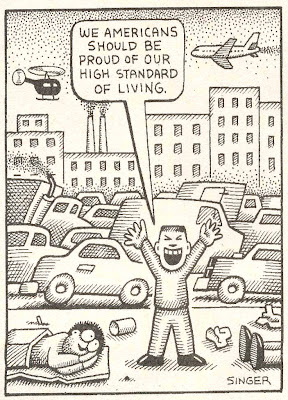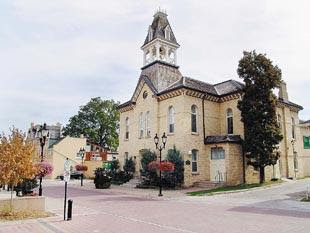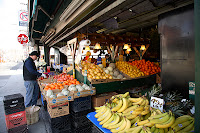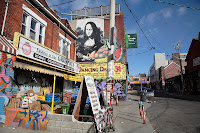
This blog exists to inspire change--to become more in harmony with nature, to appreciate our beautiful planet, and to help preserve it for future generations.
Sunday, October 28, 2007
The American way of life is a blessed one?

Monday, October 22, 2007
Air pollution decreases on Yom Kippur in Israel

Daddy! Mommy!" The traffic lights are madly blinking stop! Go! Stop! Go! And of course, no one is taking any notice. The birds are calling to each other above the roof tops. Caw caw!! Chirp chirp!! Wooooo wooooooo goes the dry north wind. You can even hear crickets by the usually bustling beachfront promenade. it is all quite delightful.
By Zafrir Rinat, Haaretz Correspondent
Air pollution in Jerusalem and the Dan region was 100 times less on Yom Kippur than on ordinary days, when cars are on the roads, air pollution monitors from the Environmental Protection Ministry found.
Thursday, October 18, 2007
Street car was desired in York Region of old

Newmarket street car service? It's been done before
Tuesday, October 16, 2007
Green Party's Vision for transportation

The Green Party's full vision can be found here
http://www.greenparty.ca/en/policy/visiongreen?origin=redirect
Railroads – re-establishing the national dream
Canada’s national rail systems are in decline. We are the only country in the Organization of Economic Cooperation and Development (OECD) with no national transportation strategy. While Europeans have highly efficient inter-modal connectivity, with high speed rail linking downtown cores to airports, with bicycle lanes allowing people to move around cities safely, efficiently and pollution-free, with streetcars in the downtowns and even rural areas serviced by bus and rail, Canadian communities are increasingly stranded. Nothing links our downtowns to airports other than a stretch of gridlocked traffic. Even along the Windsor-Quebec corridor, passenger rail is increasingly infrequent and outmoded. In much of Canada, rail routes that once moved thousands of people are abandoned. Edmonton to Calgary, Saskatoon to Regina, Halifax to Sydney have all been axed, despite their profitability.
Vision
Sir John A. Macdonald understood that to be a nation, to have a sense of shared identity and common purpose, Canada needs effective east-west links in communications, in energy delivery and in transportation.
To renew this “national dream” today requires a complete overhaul of our rail system for both passenger and freight. It will mean shifting cargo containers off highways and onto freight trains, driving the development of freight distribution nodes (off-loading containers onto local trucks) along new “green corridors”.
The rail system changes will include a separate line for passenger trains. At the moment, freight owns the tracks and controls the traffic signals. Passengers are at the mercy of freight. New high-speed commuter trains will almost halve the travel time between Toronto and Ottawa and Toronto and Montreal to about two and a half hours. With downtown-to-downtown service, the train will be faster than the plane, especially when security and other airport delays are factored in. Reducing air travel will reduce greenhouse gases and remove the need to expand airports or build new ones, including the Pickering airport near Toronto. Better rail service will take cars off the roads between major cities, reducing air pollution, congestion and loss of life in traffic accidents. An improved rail system will make Canada more economically competitive and provide thousands of new jobs.
Green Solutions
Green Party MP’s will re-establish Canada’s National Dream and:
- Re-invest in our national rail systems, building more train cars in Canada, and create green transportation and energy infrastructure corridors in key regions.
- Improve rail infrastructure and intermodal connections, increasing joint federal-municipal light rail investments, as well as improving VIA rail service nationwide.
- Work with railway companies to improve rail infrastructure and to restore VIA rail service to all major regional cities.
- Create a national clean freight initiative, using both regulation and financial incentives to improve fleet efficiency and safety.
- Support the trucking industry, reducing pollution through add-on generators to avoid the need to idle to maintain air conditioning and refrigeration, while ensuring the right fit of trucking in a more efficient, rail-based intermodal system.
Urban sprawl means commuters crawl. More roads don’t solve the problem, they make it worse, quickly filling up with more cars. Gridlock means more air pollution and greenhouse gas emissions. We have to break this vicious cycle.
Vision
We must build our way out of the problem of clogged roads and smog-choked cities, not by building more roads and bridges and more distant suburbs, but with “smart growth” infrastructure. Excellent public transit and efficient housing in high-density nodes along existing transit corridors will make cities livable and people friendly. The federal government must take the lead in funding the “greening” of Canada’s cities. (For more details also see the section on government: Federal-Municipal Relations.)
Green Solutions
Green Party MPs will:
- Increase federal funding for pedestrian, cycle and car-sharing infrastructure in towns and cities.
- Double existing funding to stimulate a massive re-investment in public transportation infrastructure in all Canadian towns and cities to make it convenient, safe, comfortable and affordable.
- Make transit passes tax-deductible to encourage workers and businesses to use public transport and provide financial support to provinces that provide free public transit passes to people living below the poverty line.
- Cancel all funding for specific highways and bridge expansions (like the Gateway Program in Greater Vancouver) that encourage urban sprawl, increase private vehicle use, truck transport of goods and consequently increases greenhouse gas emissions.
- Ensure federal infrastructure funding does not go to expanding highways and roads.
Monday, October 15, 2007
Saturday, October 13, 2007
Friday, October 12, 2007
New roads make it easy to ignore public transit
October 9, 2007
MCNAUGHTON ROAD EAST
“The completion of the McNaughton Road extension will have a positive effect on our community as it will allow the City to provide the appropriate infrastructure to relieve gridlock through Maple on Major Mackenzie and help attract and retain businesses,” said Mayor Linda Jackson. “The extension is especially important to the redevelopment and intensification of the existing Civic Centre site.”
York Major Holdings constructed the capital work on the City’s behalf in order to accelerate the development of their nearby lands. City Council authorized completion of the extension in April 2003.
“The extension and the development of York Major Holdings’ land is an important part of the City’s strategy with respect to the closure of the Keele Valley Landfill,” said Ward 1 Councillor Peter Meffe. “It will also encourage redevelopment of the secondary buffer zone of the landfill.”
The new four-lane road runs east 1.6 kilometres and connects to the existing
The extension is adjacent to the former Keele Valley Landfill Site. These lands, with an area of approximately 245 hectares, are being rehabilitated under the Maple Valley Plan that includes new parkland and natural open spaces, and some commercial development.
The Record
Thu
New roads make it easy to ignore public transit
Byline: Shelley Maw
As long as we continue to build more roads in
Human beings do not change their ways of doing things until their current method becomes unbearable, and when there is an alternative that is reasonably convenient and affordable.
If we keep making driving easier and more convenient, we might as well save our breath (and our money) trying to sell the idea of leaving our cars at home and taking public transit.
Why do people in this region take public transit? By far the majority of those who do, do so because they don't have an available vehicle. Why do those of us who drive not take public transit? Because it is neither easier nor more convenient. Far from it. Why do many of us take public transit to or in
Forget a new Highway 7 and the proposed 424 bypass, and give us a public transit alternative that is reasonably simple and convenient.
Eventually the traffic nightmares will push us to use it. If you solve the traffic congestion problem, we won't change our car habit.
Thursday, October 11, 2007
Has Toyota No Shame?
Toyota has sold more than one million Prius hybrids to environmentally conscious consumers who want to do the right thing for our planet.
But, incredibly, the company is now forsaking us by opposing the first improvement in U.S. fuel economy standards in nearly 20 years!
Please tell Toyota to get back in gear by supporting a measure that guarantees a fuel economy standard of 35 miles per gallon by 2020 for cars and light trucks.
Congress is negotiating an energy bill right now that could do just that -- and save America 1.2 million barrels of oil each day by 2020, more than we import from Saudi Arabia.
But the Alliance of Automobile Manufacturers -- the powerful lobbying group that includes Toyota -- is claiming that a 35 m.p.g. average for cars and trucks is "unattainable."
Go tell the maker of the 50-m.p.g. Prius to get out of reverse!
Thank you for taking action to reduce America’s dangerous dependence on oil.
Wednesday, October 10, 2007
Tuesday, October 9, 2007
Bells on Bloor 2007
dubbed TaketheTooker.
Viva ! La Velorution !
..~......__o..__o
.~.. _.-\.<,.-\.<,_
~...(_)./.---./....(_)
Monday, October 8, 2007
Some modest proposals to liberate city streets
A conference here this week aimed to turn around a half-century of car-driven urban planning, Oct 06, 2007 04:30 AM
The sidewalks are wide. They're lined with flowers and trees. There's a bus stop, a bench, maybe even a small park. There's room for bikes and cars, but children and seniors don't have to worry about being run over.
That's the street everybody wants to live on, shop on, work on and walk on.
The planners and engineers know how to build it.
So, why are so many of us trapped in labyrinthine suburbs where, even if we want to walk, we imperil our lives doing so on the gravel shoulders of arterial roads?
There are significant challenges to altering more than half a century of automobile-centred urban design, not the least of which is political inertia, according to the experts at an international walking conference here this week.
But there's also a growing movement of pedestrians and cyclists ready to turn the transportation hierarchy on its head – to put people ahead of cars.
New developments can be made walkable, according to Dutch traffic engineer Hans Monderman, considered a maverick for his designs that rely more on human behaviour and less on road signs – eliminating elements like traffic lights, stop signs and lane markers altogether – to encourage civil traffic patterns.
 "If you want people to behave like they're in a village, you have to build a village," he said.
"If you want people to behave like they're in a village, you have to build a village," he said.
Put car windows at a level closer to curb height so motorists see pedestrians differently. Vary paving materials and landscaping according to space use. People will instinctively know what to do, says Monderman.
The British conference chair of Walk21, Jim Walker, says he's seen "lots of disgusting places, but they can be sorted."
Other cities that have hosted the event wanted to show off their pedestrian-friendly strides.
Toronto was different, Walker said, because it chose the conference as the launch date for its new pedestrian strategy, part of a sustainable transportation plan to reduce reliance on the car.
The revolution is already under way in places like Kensington Market, now closed to cars on Sunday. St. George St. south of Bloor St. is another example.
"Ten years ago, (St. George) was a four-lane road with very narrow sidewalks and no landscaping and the very simple act of brilliance was to get rid of two traffic lanes, widen the sidewalks and landscaping. (Now) the sidewalks are full all the time and you have a beautiful street with trees that will eventually arch and meet in the middle," says Toronto's former planning chief, Paul Bedford, now a teacher and consultant.
Bedford can't resist adding that a hefty private donation helped embarrass the city and the University of Toronto into tackling the project.
But it doesn't work everywhere. In 1971, Yonge St. between and King and Gerrard Sts. was turned into a pedestrian mall.
"It was great for a (while), but even though there was no traffic, people migrated naturally to the sidewalks because they didn't feel like they should walk in the middle of the road," said Bedford.
Experts admit it's tougher to retrofit the worst of 1960s- and 1970s-style planning in the old suburbs of Toronto or places like Oakville and Pickering.
Perhaps we don't view walking as an integral part of our lives like Europeans, suggests Walk21's Daniel Egan, Toronto's manager of cycling and pedestrian infrastructure.
North Americans "spend thousands of dollars to go to those places (like Europe) and walk around and then you come back to your suburban bungalow and drive everywhere.
"I don't think it's necessarily political, I think it's part of the culture where that's something you go and enjoy but you don't actually live in it," he said.
"I don't know how you turn back the clock. All these places that are great are old. They were built at a time when walking was the way you got around." Kensington Market in Toronto has pedestrian Sundays. One doesn't fully appreciate the joy of being in a carfree zone until experiencing it firsthand. "The streets echo to human sounds: footsteps, voices, whistling porters, street musicians. People dawdle without worrying about onrushing traffic. " Carfree Cities, J.H. Crawford.
Kensington Market in Toronto has pedestrian Sundays. One doesn't fully appreciate the joy of being in a carfree zone until experiencing it firsthand. "The streets echo to human sounds: footsteps, voices, whistling porters, street musicians. People dawdle without worrying about onrushing traffic. " Carfree Cities, J.H. Crawford.The stink, roar, and danger of car and truck traffic inhibit street life.
FEET FIRST
Five ways to make more walkable cities as heard at Walk21 conference:
1. Widen sidewalks to accommodate pedestrians and put curves in roads to slow traffic. Add planters as an alternative to repaving.
2. Get rid of signs that state the obvious. Street design and buildings will tell people where to go and how to behave.
3. Bring back benches, bathrooms and drinking fountains, as well as mixed-use development.
4. Safe streets are busy streets. One way to fight intimidation is to attract lots of people.
5. Subways are expensive. You could build enough bike and pedestrian infrastructure to serve the entire region for the same price as a few kilometres of subway.
Friday, October 5, 2007
Transportation key election issue in York Region
COLUMN
No one route to better commute
By: Sean Pearce
As anyone who wakes up impossibly early every weekday morning to make the trek to Toronto for work well knows, traffic congestion isn’t going away.
Far from it.
The drive home isn’t much better.
It is then safe to say, in terms of transportation issues, York Region faces a multitude of obstacles, but has a myriad of possible solutions at its disposal.
In terms of improving public transit in the region, each party presents a slightly different approach, but all agree more is needed.
Is the subway even the best possible solution for York Region in the long haul? The Progressive Conservatives don’t seem to think so. The PCs, under John Tory, have vowed to create a new funding model for Ontario, one that sees all gas tax collected going back to municipalities.
More to the point, the much touted plan for the subway, seeing as how it may take at least four to five years to get things under way, might simply be too little too late.
The time for rapid transit and action is now, Mr. Tory said.
Roads
The Liberals seem to have recognized this and have been working away building and expanding the province’s network of high occupancy vehicle lanes in the hope if people must drive, they will, at the very least, carpool.
The PCs, among them former minister of transportation Frank Klees, have come out saying York Region needs more than future subways and even enhanced transit.
The fact remains voters are looking for action on the congestion issue and it is likely whichever proposal is most sound, the real answer will likely be a multi-pronged approach. Is more and improved public transit needed? Yes, absolutely. Too many people complain schedules are inconvenient for their lives or routes don’t go where they need them to go, so, instead, they drive.
Hopefully, as the HOV network continues its expansion, more people will be encouraged to travel with others, but the fact remains many people in this region still continue their age-old love affair with the automobile.
Monday, October 1, 2007
People-friendly streets
 TheStar.com - editorial
TheStar.com - editorialOctober 01, 2007
The car has ruled Toronto's streets, and those of other cities, for decades. Now, a promising movement is afoot to ease that domination by better serving the needs of pedestrians, cyclists and transit riders.
Simply increasing the time allowed at stop lights for pedestrian crossings would make a big difference. Another proposed change is to stop all traffic, in all directions, for pedestrians at some intersections. This "scramble phase" would allow people to walk diagonally, from one corner to another, completing two street crossings at once. The report calls for such a system next year, on a trial basis, at the intersection of Bloor and Yonge Sts., and at Bloor and Bay Sts.

